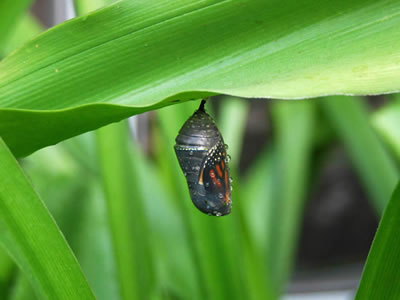Monarch Butterfly (Danaus plexippus)
By Janet Ekstrum U.S. Forest Service
The Migratory Monarch
The monarch butterfly (Danaus plexippus) is among the most recognized, studied, and loved of all of North America’s insects. Children study monarchs in school. Researchers and citizen scientists track their migration and breeding. Conservationists and government agencies are concerned about threats to breeding, migration, and wintering habitats.
The monarch butterfly life cycle, like other insects, has several life forms and stages prior to reaching adulthood. The monarch has four distinct life stages: egg, larva (caterpillar), pupa (chrysalis), and adult. Milkweed and flowering plants are needed for monarch habitat. Adult monarchs feed on the nectar of many flowers, but they must have milkweed to breed and develop into a butterfly.

Monarchs can travel between 50-100 miles a day. It can take up to two months to complete their journey. The farthest ranging monarch butterfly recorded traveled 265 miles in one day.
 Monarch caterpillar on milkweed. Photo by Dick Walton, Monarch Monitoring Project.
Monarch caterpillar on milkweed. Photo by Dick Walton, Monarch Monitoring Project.
The annual migration cycle of the monarch butterfly has been described as the most spectacular in the insect world. The monarch is the only butterfly known to make a two-way migration as birds do. Monarchs use a combination of air currents and thermals to travel long distances. Some fly as far as 3,000 miles to reach their winter home! Monarchs in Eastern North America have a second home in the Sierra Madre Mountains of Mexico. Monarchs in Western North America overwinter in California. This species and its continuing migration are dependent upon conservation of habitats in all three North American countries: Canada, the United States, and Mexico.
Awareness of the monarch butterfly’s life cycle and habitat requirements is essential for their survival and an important step in the conservation of this animal. Many government agencies, organizations, and individuals across North America are working on projects to conserve monarch habitats and their migration. Citizen scientists from across the United States and Canada volunteer to help collect long-term data on larval monarch populations and milkweed habitat.
The Monarch Butterfly in North America

The Monarch Butterfly in North America website is a gateway to news, information, activities, and resources about the biology and conservation of this fascinating insect. This website is a cooperative effort with the North American Pollinator Protection Campaign (NAPPC) and agencies of the U.S. Department of the Interior and the U.S. Department of Agriculture dedicated to educating the public and increasing understanding monarch butterfly biology and conservation. Check it out!
The Monarch Butterfly in North America…
More Information
- Wings Across the Americas, Monarch Butterfly Program - U.S. Forest Service International Programs




